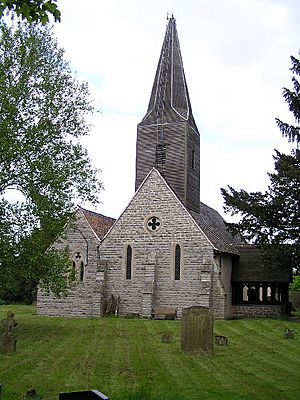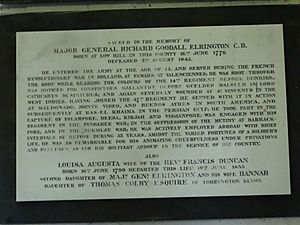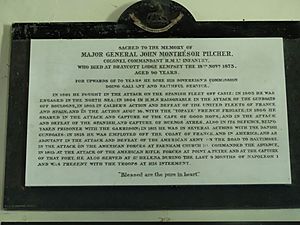St John the Baptist, White Ladies Aston facts for kids
Quick facts for kids St John the Baptist, White Ladies Aston |
|
|---|---|

St John the Baptist, White Ladies Aston
|
|
| 52°10′21″N 2°06′55″W / 52.17255°N 2.11534°W | |
| OS grid reference | SO 92209 52703 |
| Location | White Ladies Aston |
| Country | England |
| Denomination | Church of England |
| History | |
| Dedication | St John the Baptist |
| Architecture | |
| Heritage designation | Grade II* listed |
St John the Baptist Church is a special old building in White Ladies Aston, England. It's so important that Historic England has given it a "Grade II* listed" status. This means it's a very important historical building.
A Look Back in Time
How the Church Began
The church of St John the Baptist is very old, dating back to 1204! That's over 800 years ago. A man named Robert de Everay gave two horses to the Bishop of Worcester. This gift helped him get the right to choose a vicar for the area. He also planned to build a stone church. Today, that stone church still stands, with a wooden spire. The main entrance is from the Norman period, and the font (where baptisms happen) is likely from the 1200s.
The White Ladies Connection
In 1255, Aston was renamed White Ladies Aston. This was because of its link to Whistones Priory, which was home to Cistercian nuns. These nuns received land and other gifts from the church. This connection lasted until 1536. At that time, King Henry VIII closed many monasteries, including Whistones Priory. This was part of a big change in England, moving from the Roman Catholic Church to the Protestant Church.
Old Timbers and Bells
The oldest wooden parts in the church's tower and spire are from the 1400s. Imagine, they are over 600 years old! In 1410, a new bell was bought for the church.
Times of Change
During the 1600s, England faced the English Civil War. This led to different religious groups and some disagreements, even at St John the Baptist Church. For example, in 1652, the church's leader, John Moseley, was removed because of his sermons against the Quakers. Later, in 1661, another leader was removed for supporting the Parliament during the time King Charles II returned to power.
A Long-Serving Vicar
The Reverend Henry Martyn Sherwood was the vicar of White Ladies Aston Church for a very long time, from 1839 to 1910. He was one of the longest-serving vicars in the Church of England! He helped make many changes in the village. He made the church bigger, helped with education, improved roads, and created a Parish Room for the community.
Church Repairs and Improvements
In 1848, the church was in poor condition. One person described it as having "broken glass" and very high pews that blocked the view of the congregation.
Big building work happened in 1861. A new North Aisle and Vestry were added. The old stonework and timbers were fixed. New pews were put in, increasing the seating from 73 to 155 people. An avenue of 22 yew trees was planted along the path to the church. This was to celebrate each year Rev. Sherwood had been vicar.
The Worcestershire Sauce Connection
A large donation for the church repairs came from Mr. Perrins of Worcester. His family had a long-standing debt of gratitude. Mr. Perrins' grandfather, who owned a chemist's shop, made an Indian sauce. This sauce became the famous Worcestershire sauce! Captain Sherwood, Rev. Sherwood's father, suggested that Mr. Perrins should sell it. The company, Lea & Perrins, became very successful. The Perrins family had promised a reward to Captain Sherwood's son, Rev. Sherwood. This offer was made every year but was always politely declined until this time, when it helped pay for the church repairs.
Later Additions
In 1864, a new porch was added to the church. The beautiful East Window was installed in 1938. In 1985, the wooden spire was repaired.
Outside the Church
The church is in a quiet churchyard, north of the village. You reach it by walking along a path lined with yew trees. You enter through a wooden porch, built in 1864, which leads to a Norman doorway on the south side of the church.
The wooden tower on the west side has a graceful spire. The main timbers in this spire are very old, dating back to around 1545. That's about the same age as the famous ship, the Mary Rose! The roof of the chancel (the area near the altar) is a bit lower than the main part of the church. On the north side, there's an aisle and a vestry, both added in 1861.
Inside the Church
Inside, the church feels bright and welcoming. The walls are painted a light cream color. The arches inside are made of alternating light and darker stone. The tower is supported by large wooden beams and an iron column.
The ceiling of the main part of the church is plastered. The chancel roof has some exposed wooden beams. The chancel arch, which separates the chancel from the main area, is a rounded type.
Church Furnishings
Most of the church's furniture, like the seating, was added during the 1861 restoration. The pulpit, where sermons are given, is made of wood. An old piece of wood that used to hold a sounding board (to help the speaker's voice carry) still hangs on the wall nearby.
The font is twelve-sided and very old, probably from the Middle Ages. It has carvings on its sides and marks where old locks used to be. Fonts were sometimes locked to protect the holy water inside.
Memorials and Tablets
The 1700s were a time when England became a powerful country, involved in wars around the world. People from White Ladies Aston were part of these events. Some of these individuals and their stories are remembered on special plaques inside the church.
- Captain Thomas Elrington: He died in 1809 at 87 years old. He served in the army for 65 years! He was part of important events like the Jacobite Rebellion of 1745 and the Seven Years' War in North America.
- Major General Richard Goodall Elrington: Born in White Ladies Aston in 1776, he became a Major-General in 1841. He joined the army at just 14 years old during the French Revolutionary Wars and served in many places around the world.
- Major General John Montresor Pilcher: Born in 1783, he married Elizabeth Mary Elrington from Low Hill House. He was involved in many naval events between 1801 and 1815. He was even present when Napoleon died on St. Helena.
- Hamilton Thomas Gordon: Born in 1836, he became a Lieutenant in the Bengal Engineers in India in 1855. He died in Calcutta at the age of 24.
World War I Memorial
A special plaque in the church remembers villagers from White Ladies Aston who lost their lives in World War I (also known as the Great War). Four names are listed: David Gould, William Edwin Judd, Daniel Pearce, and William Henry Shuck.
- Corporal David Gould: He was 31 when he was killed in action on July 7, 1916. He was an agricultural worker who volunteered to join the army. He died during an attack on the German stronghold of the Leipzig Salient in France.
- William Judd: He died on January 9, 1917, at the age of 23.
The last 100 days of World War I were very difficult for White Ladies Aston.
- On August 29, 1918, Second Lieutenant Hamilton Stanley Sherwood, the grandson of the long-serving Reverend Sherwood, was killed near Bethune, France, at just 19 years old.
- On September 3, Henry John Page, connected to the village, was killed in Northern France at 22.
- On October 8, Daniel Pearce, 22, was killed near Vis en Artois, Northern France.
- On October 30, William Henry Shuck, 30, was killed in Beirut.



